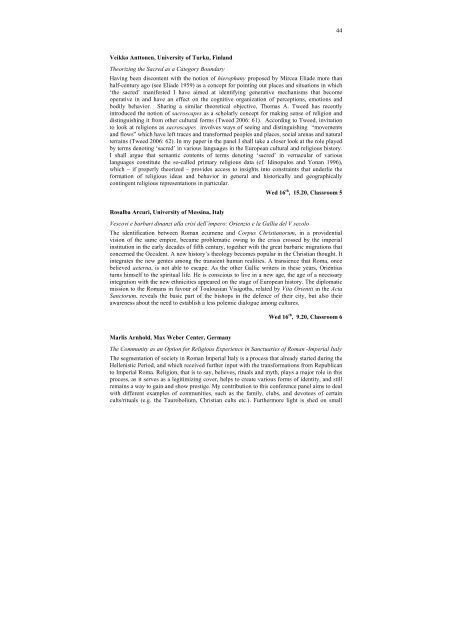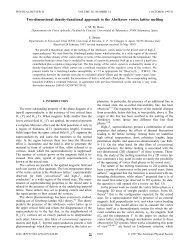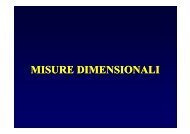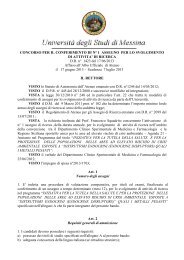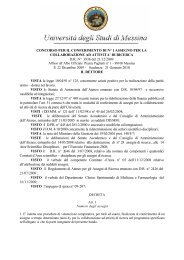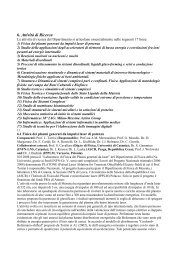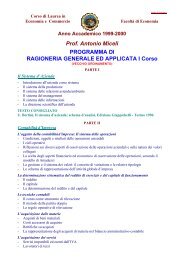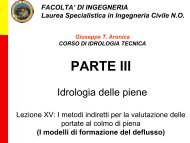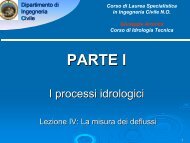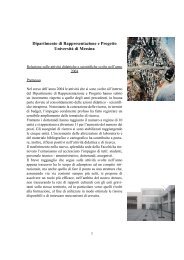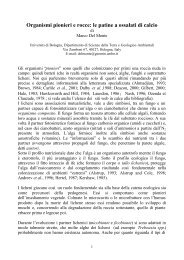PROGRAMME AND ABSTRACTS - Università degli Studi di Messina
PROGRAMME AND ABSTRACTS - Università degli Studi di Messina
PROGRAMME AND ABSTRACTS - Università degli Studi di Messina
Create successful ePaper yourself
Turn your PDF publications into a flip-book with our unique Google optimized e-Paper software.
Veikko Anttonen, University of Turku, Finland<br />
Theorizing the Sacred as a Category Boundary<br />
Having been <strong>di</strong>scontent with the notion of hierophany proposed by Mircea Eliade more than<br />
half-century ago (see Eliade 1959) as a concept for pointing out places and situations in which<br />
‘the sacred’ manifested I have aimed at identifying generative mechanisms that become<br />
operative in and have an effect on the cognitive organization of perceptions, emotions and<br />
bo<strong>di</strong>ly behavior. Sharing a similar theoretical objective, Thomas A. Tweed has recently<br />
introduced the notion of sacroscapes as a scholarly concept for making sense of religion and<br />
<strong>di</strong>stinguishing it from other cultural forms (Tweed 2006: 61). Accor<strong>di</strong>ng to Tweed, invitation<br />
to look at religions as sacroscapes involves ways of seeing and <strong>di</strong>stinguishing “movements<br />
and flows” which have left traces and transformed peoples and places, social arenas and natural<br />
terrains (Tweed 2006: 62). In my paper in the panel I shall take a closer look at the role played<br />
by terms denoting ‘sacred’ in various languages in the European cultural and religious history.<br />
I shall argue that semantic contents of terms denoting ‘sacred’ in vernacular of various<br />
languages constitute the so-called primary religious data (cf. I<strong>di</strong>nopulos and Yonan 1996),<br />
which – if properly theorized – provides access to insights into constraints that underlie the<br />
formation of religious ideas and behavior in general and historically and geographically<br />
contingent religious representations in particular.<br />
Rosalba Arcuri, University of <strong>Messina</strong>, Italy<br />
44<br />
Wed 16 th , 15.20, Classroom 5<br />
Vescovi e barbari <strong>di</strong>nanzi alla crisi dell’impero: Orienzio e la Gallia del V secolo<br />
The identification between Roman ecumene and Corpus Christianorum, in a providential<br />
vision of the same empire, became problematic owing to the crisis crossed by the imperial<br />
institution in the early decades of fifth century, together with the great barbaric migrations that<br />
concerned the Occident. A new history’s theology becomes popular in the Christian thought. It<br />
integrates the new gentes among the transient human realities. A transience that Roma, once<br />
believed aeterna, is not able to escape. As the other Gallic writers in these years, Orientius<br />
turns himself to the spiritual life. He is conscious to live in a new age, the age of a necessary<br />
integration with the new ethnicities appeared on the stage of European history. The <strong>di</strong>plomatic<br />
mission to the Romans in favour of Toulousian Visigoths, related by Vita Orientii in the Acta<br />
Sanctorum, reveals the basic part of the bishops in the defence of their city, but also their<br />
awareness about the need to establish a less polemic <strong>di</strong>alogue among cultures.<br />
Marlis Arnhold, Max Weber Center, Germany<br />
Wed 16 th , 9.20, Classroom 6<br />
The Community as an Option for Religious Experience in Sanctuaries of Roman -Imperial Italy<br />
The segmentation of society in Roman Imperial Italy is a process that already started during the<br />
Hellenistic Period, and which received further input with the transformations from Republican<br />
to Imperial Roma. Religion, that is to say, believes, rituals and myth, plays a major role in this<br />
process, as it serves as a legitimizing cover, helps to create various forms of identity, and still<br />
remains a way to gain and show prestige. My contribution to this conference panel aims to deal<br />
with <strong>di</strong>fferent examples of communities, such as the family, clubs, and devotees of certain<br />
cults/rituals (e.g. the Taurobolium, Christian cults etc.). Furthermore light is shed on small


